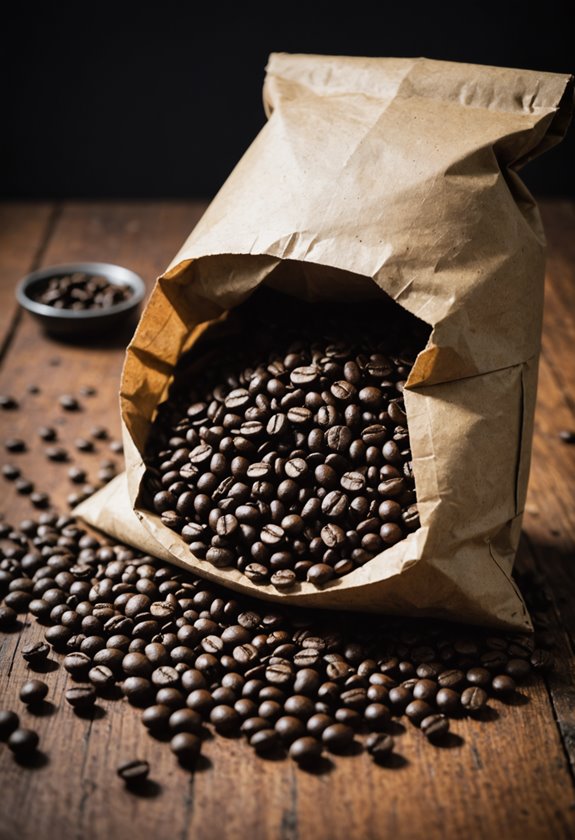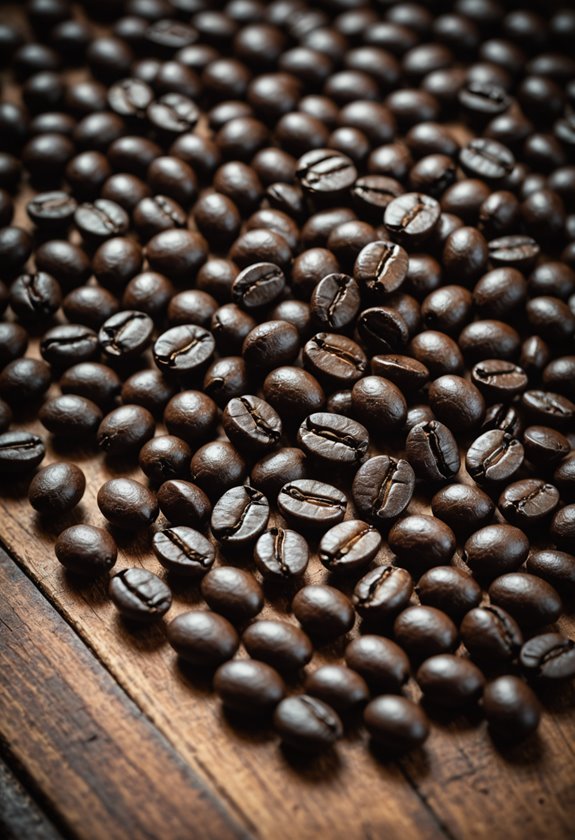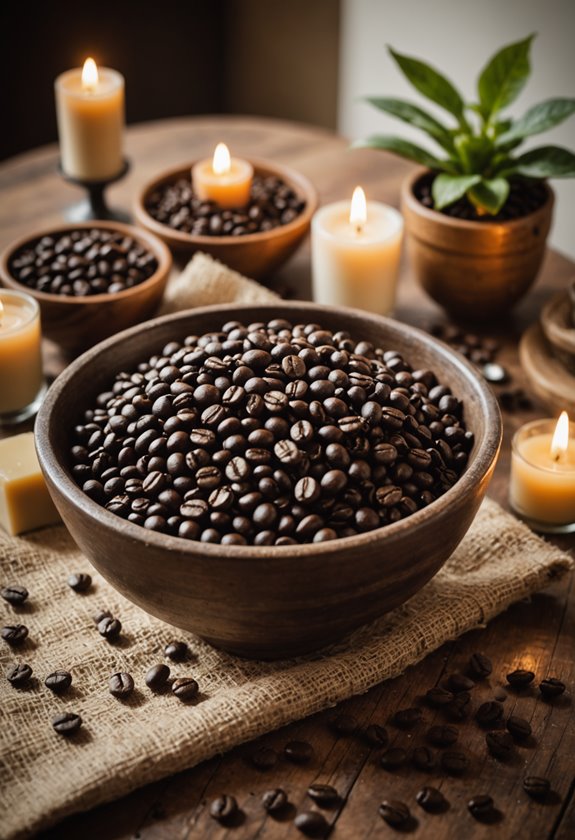How Long Do Coffee Beans Last in the Bag?
When stored in their original vacuum-sealed bags, coffee beans can stay fresh for 6 to 9 months. If these bags are also nitrogen-flushed, you might enjoy that freshness for up to 2 years. Keep the beans in a cool, dark, and dry spot to slow down oxidation and preserve flavor. Once opened, transfer them to an opaque, airtight container to maintain their importance. Avoid refrigeration as it can cause unwanted flavor changes. Remember, whole beans can outlast pre-ground ones, which start losing flavor quicker. Let's examine how these practices impact your coffee experience and uncover more storage observations.
Key Takeaways
- Unopened roasted beans remain fresh for about 6 weeks.
- Vacuum-sealed bags extend bean freshness to 6-9 months.
- Nitrogen-flushed bags can maintain quality for up to 2 years.
- Whole beans last longer than ground, preserving taste for 6-9 months.
- Proper storage in a cool, dry place helps prolong freshness.
Lifespan of Sealed Beans

When it comes to the lifespan of sealed coffee beans, understanding the subtleties of their packaging can make a significant difference in maintaining their freshness. Whole coffee beans in a sealed bag can last for quite a while, but several factors influence their longevity.
For instance, an unopened bag of roasted beans will generally stay fresh for about 6 weeks. However, vacuum-sealed bags can extend this freshness to about 6-9 months. This is because the oxidation process is markedly slowed, preserving the beans longer. Storing beans in airtight containers helps preserve their natural oils and flavors.
Let's investigate why some beans last longer than others. The vacuum-sealed bag plays an essential role in extending the shelf life of coffee. By removing air, it prevents the oxidation process that leads to flavor deterioration.
When stored properly, even vacuum-packed beans can maintain quality for up to 2 years, especially if they're in nitrogen-flushed bags.
The expiration date on your coffee package serves as a guideline, indicating when you'll likely experience a decline in flavor.
Ground coffee beans lose their freshness much faster than whole beans, typically becoming stale within a week.
Storage Techniques
Having investigated the longevity of sealed coffee beans, let's now focus on how to store them properly to savor their peak freshness.
To maximize their flavor, store your coffee beans in a cool, dark, and dry place. Heat, light, and moisture can cause your coffee to lose its flavor quickly. Grinding beans just before brewing delivers the most flavorful coffee experience.
Once you open that pack, transfer the beans into an opaque, airtight container. This will protect them from exposure to air and humidity, which are major culprits in making coffee go stale.
Vacuum-Sealed Bags
Unopened vacuum-sealed bags are excellent for long-term storage. They minimize air exposure and can keep coffee beans fresh for up to 6-9 months.
However, once you break the seal, it's best to consume within 3 to 30 days post-roasting for the optimum taste.
Avoid the Fridge
Though it might seem tempting, avoid refrigerating or freezing your whole coffee beans.
These environments can lead to unwanted flavor absorption from other foods. They also create condensation, which introduces moisture and speeds up staleness.
If using a coffee bean hopper, weekly refills are recommended to maintain optimal freshness of your beans.
Identifying Stale Beans

Detecting stale coffee beans is crucial to enjoying a flavorful cup. Let's investigate how to spot them.
Fresh coffee beans have a strong, fragrant aroma, while stale beans often lack scent, indicating a loss in quality. Pay attention to the smell when you open the bag; if it's weak or musty, the beans might be past their prime.
A visual inspection is another effective method. Fresh beans should exhibit a glossy sheen due to their natural oils. If they appear dry and matte, you're likely dealing with stale beans. This dull texture is a sign they've lost their freshness.
When brewing, taste can also be a giveaway. Fresh beans provide lively flavors, whereas stale ones may result in a dull or bitter taste. Bitterness is a common sign of aging, impacting the overall quality of your cup.
Be cautious of moldy coffee beans or grounds. Mold not only compromises the quality but can also pose health risks. If you notice any mold, discard them immediately.
Whole vs. Ground Beans
Spotting stale coffee beans sets the foundation for choosing between whole and ground options. When it comes to preserving freshness, whole coffee beans are the way to go. Whole roasted beans can last about 6-9 months in vacuum-sealed bags, maintaining their rich flavor and aroma.
Once you open them, try to consume within 6 months for the best taste. Ground coffee, on the other hand, offers convenience but comes with a shorter shelf life. Due to its larger surface area, ground coffee beans start losing freshness faster, lasting only 3-5 months in vacuum-sealed packaging.
Understanding Oxidation and Flavor
Oxidation is the enemy of coffee bean flavor. With whole beans, this process slows down because they're less exposed to air, preserving the taste and aroma longer.
Ground coffee, though, begins losing its quality immediately after grinding. For peak flavor, it's best to grind whole beans just before brewing. Using airtight containers helps, but can't stop flavor deterioration after about 2 weeks.
Maximizing Freshness
Creative Uses for Old Beans

Old coffee beans still hold potential beyond brewing, offering a variety of creative uses that can breathe new life into them. You might think aged coffee beans are only useful for their intended purpose, but they can be quite versatile.
Let's investigate some inventive ways to repurpose them.
Invigorating Beverages and Desserts
You can create a rich cold brew from old coffee beans, providing an invigorating drink with a deep flavor. Just steep them overnight in cold water, and you'll have a beverage that's both flavorful and satisfying.
When it comes to desserts, incorporate aged coffee beans into treats like tiramisu or coffee-flavored cakes, adding a layer of complexity.
Edible Treats and Crafts
For a unique treat, coat stale coffee beans in chocolate. It's a combination that balances bitterness with sweetness.
If you're into crafts, use these beans to make artwork or even as a natural dye for fabrics, offering a unique tint that's eco-friendly.
Gardening Benefits
Old coffee beans also serve as excellent compost material.
When used in gardening, they enhance the soil with beneficial nutrients. These nutrients support plant health and growth, turning your expired beans into a garden asset.
Choosing Coffee Subscriptions
How do you guarantee your coffee is always fresh and flavorful? A coffee subscription might just be your answer. By subscribing, you secure regular deliveries of coffee beans, avoiding the risk of staleness that comes with buying in bulk. Freshly roasted coffee beans arrive at your doorstep, ready to delight your taste buds with every brew.
Whether you prefer whole beans or ground coffee beans, subscriptions offer customization to suit your brewing methods and taste preferences.
Let's investigate the benefits further. Many coffee subscription services deliver a diverse selection, including single origin, blends, and unique roasts. This variety caters to different taste preferences, making sure you always have something new to try.
Delivery frequency is another customizable feature, allowing you to select weekly, bi-weekly, or monthly shipments based on your consumption rate. This flexibility guarantees you're never without a fresh bag of coffee beans.
Moreover, some subscription services emphasize quality and freshness by sourcing beans from small-batch roasters. This approach prioritizes quality over mass production, ensuring each cup is rich and flavorful.
Frequently Asked Questions
Do Bagged Coffee Beans Go Bad?
Yes, bagged coffee beans do go bad. You'll notice they lose aroma and flavor over time. Store them properly in an airtight container to maintain freshness, and consume within recommended time frames for the best taste.
Are 2 Year Old Coffee Beans Still Good?
You can use two-year-old coffee beans if they were stored well. Check their aroma and appearance. If there's no mold or rancid smell, they're safe but may lack flavor. Try them in cold brews or baking.
Can You Use 10 Year Old Coffee Beans?
You shouldn't use 10-year-old coffee beans. They'll likely taste stale and bitter. While they're not harmful if mold-free, you'll miss out on the rich flavor and aroma. For a better brew, choose fresh beans instead.
How to Tell if Coffee Beans Are Too Old?
Check the beans' aroma and texture. If they smell weak or feel dull, they're likely too old. Look for surface oil and sheen; absence suggests staleness. Mold presence means immediate disposal. Trust your taste test for confirmation.
Conclusion
Let's wrap it up: Coffee beans, when sealed, have a surprisingly long shelf life, but proper storage is key to preserving their flavor. Remember, whole beans last longer than ground ones, so grind them just before brewing. Be vigilant for signs of staleness, like a flat aroma or taste. If your beans do go stale, consider creative uses instead of tossing them. Finally, investigate coffee subscriptions to guarantee you always have fresh beans on hand. Happy brewing!







